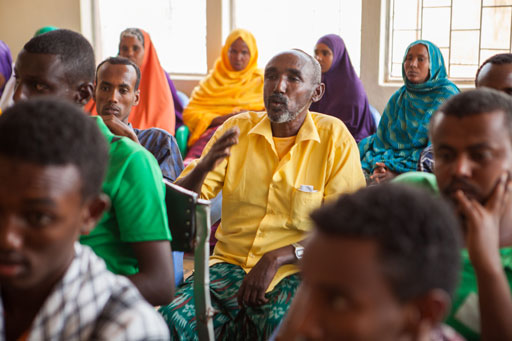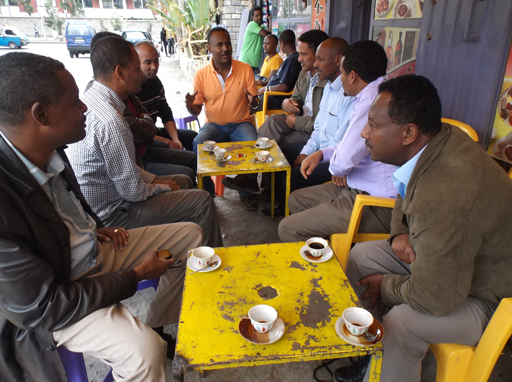3.5 Assessment methods
Assessing the key sanitation and hygiene aspects of a community requires the use of a number of investigation methods. The main methods (Asefa and Tessema, 2000; Feleke et al., 2003) are listed below:
- Interviews are conversations between the investigator and members of the community, usually on a one-to-one basis. Depending on the information required, different types of interviews and questions can be used, as described in Box 3.1. The interviewer takes notes of the interview or uses a voice recorder. When conducting interviews it is important to gain the interviewee’s consent before starting and to make it clear how the information will be used. Generally, interviewee’s comments should not be used in reports in a way that allows the person to be identified.
- Observation is often combined with interviews. Observation simply means recording what you see or are aware of. For example, while visiting households, interviewers observe the availability and quality of the sanitation and waste facilities, such as the household latrine, solid waste storage and disposal, and handwashing provision. In addition, the interviewer will try and gain a picture of the use of these facilities through observation and discussions. At the same time, the general condition of the housing, water management and food handling can also be observed. There is a risk that the observer will assess the position against their own personal views (a subjective view), so it is important to have a set of standards to be used by all observers to make the assessment as objective (based on things that can be measured or counted and not influenced by personal opinion) as possible. General observations can be made simply by walking around the area and noting the condition of the town. A typical observation sheet to be completed while observing a household is shown in Table 3.1.
- Discussions with the community can provide valuable information about the concerns and health situation of community members that can help to confirm the findings of the interviews and observation (Figure 3.1). For example, one would expect a high incidence of diarrhoea to be reported if an absence of latrines and handwashing facilities had been identified.
| Kebele: ____________________ Location: ____________________ | |
| 1. Where is the latrine located? | |
| (a) Inside or attached to dwelling | (c) Outside premises |
| (b) Elsewhere on premises | (d) No latrine available (Please ignore questions 2–4) |
| 2. How far is the latrine from the living quarters? | |
| (a) Less than 10 m | (c) Over 50 m |
| (b) 10 to 50 m | (d) Can’t see |
| 3. Are there signs that the latrine is in regular use? | |
| (a) Yes | (b) No |
| 4. Are there obstacles in the path from the house to the latrine? | |
| (a) The path is clear | (d) Dense vegetation |
| (b) Waste or debris in the path | (e) Mud |
| (c) The entrance is blocked | (f) Other observation: __________________ |
| 5. Is the solid waste container covered? | |
| (a) Yes | (c) No container |
| (b) No | |
| 6. Is refuse lying on the compound? | |
| (a) Yes | (b) No |
| 7. Are any of the following within 200 m of the house? | |
| (a) A place to put waste for collection by the kebele? | |
| (b) An enclosed place to dump waste used by the community? | |
| (c) An informal uncontrolled dump site? | |

- Focus groups can also be useful to find out what people think about a specific issue. A focus group consists of a group of about ten people who represent the community as a whole in terms of age, gender, employment etc. The group is coordinated by one of the team whose role is to introduce the subject and pose a few initial questions. The group then discusses the issue in question while the observer makes notes so that they can produce a summary of the group’s views and ideas. The coordinator should take as little part in the discussions as possible and only intervene if arguments develop or if the discussion strays far from the subject under discussion. An example of an informal all-male ‘focus group’ is shown in Figure 3.2.

- Questionnaires are another possible assessment method. A questionnaire consists of a set of written questions that is given to a group of people for them to complete. Questionnaires require less input from the investigators than interviews, so it is possible to get the views of a larger number of people. However, there is no opportunity for a ‘conversation’ to develop, so some useful information may be missed. A typical sample questionnaire for use by householders is shown in Table 3.2. The number of questionnaires used is always a compromise. A very large sample means that the results will be more likely to represent the entire community, but a smaller sample size will reduce the costs and the time necessary to deliver, collect and process the questionnaires. As a rule of thumb, at least 15–20 households should be surveyed in each kebele. If householders are not able to complete the questionnaire themselves, it can be used as the basis for structured interviews (see Box 3.1).
| Kebele: ___________________ Questionnaire number: __________ (to be entered by survey team) |
This questionnaire is about your household’s latrine and how you get rid of solid waste (kitchen waste, broken items, etc.). The results will be used to help us to improve the sanitation and waste services in your kebele. We will treat the results confidentially and will not be able to identify you or your family from this form. Please answer all the questions below by placing a tick in the box next to the answer or by writing a few words. |
| Questions 1–6 are about the latrine used by members of your household while at home. |
| 1. Does your household have access to a latrine? |
| (a) Yes (Please go on to answer questions 2–9) |
| (b) No (Please answer questions 7–9) |
| 2. Who usually uses this latrine facility? (Tick all that apply) | |
| (a) Mother | (e) Only females |
| (b) Father | (f) Only males |
| (c) All children | (g) Other (please specify): ______________ |
| (d) Older sons and daughters | |
| 3. When is the latrine facility used? | |
| (a) Day and night | (c) Night-time only |
| (b) Daytime only | (d) Don’t know |
| 4. Which seasons is the latrine facility used in? | |
| (a) Rainy season | (c) Throughout the year |
| (b) Dry season | (d) Don’t know |
| 5. How many households share this latrine facility? | |
| (a) Not shared | (c) Four or more households |
| (b) Two to three households | (d) Don’t know |
| 6. For how long has your household used a latrine? | |
| (a) Less than two years | (d) More than ten years |
| (b) Two to five years | (e) I can’t remember |
| (c) Six to ten years | |
| Questions 7–9 are about how you deal with solid waste in your household. | |
| 7. Where do you get information about household waste management from? | |
| (a) Radio or TV | (e) Place of worship |
| (b) Newspapers or magazines | (f) Other (please specify): _______________ |
| (c) Health professional | (g) Don’t know |
| (d) Health Extension Workers | |
| 8. Where do you keep your solid waste until you get rid of it? | |
| (a) Stored in a container in the house | (c) Take it directly to disposal |
| (b) Stored in a container outside | (d) Other (please specify): _______________ |
| 9. What is the main way you use to dispose of your solid waste? | |
| (a) A waste pit in my yard | (e) A waste pit/dump outside my yard used by other households |
| (b) In my yard without using a pit | |
| (c) Burned in my yard | (f) Dumped anywhere outside my household |
| (d) Taken to a collection point in the street | (g) Other (please specify): _______________ |
Box 3.1 Interviews and questions
Interviews and questionnaires may use closed or open questions. Closed questions offer a list of possible answers that the respondents must choose from. For example, ‘Does your household have its own latrine?’ These are very useful for obtaining this type of information, but the interviewer needs some background information about the area and the subject to know which questions to ask.
Alternatively, open questions permit free responses that should be recorded in the respondent’s own words. For example, the interviewer may say, ‘Tell me about your experiences with the shared latrine’.
A structured interview uses a standardised set of questions. These are usually closed questions with a limited range of possible answers. Each interviewee is asked the same set of questions. Structured interviews are used to obtain straightforward factual information such as the proportion of households in the kebele that have their own latrine.
In a semi-structured interview, the interviewer has a list of topics for discussion and a number of set questions (both closed and open) to help start a discussion, but he or she allows the conversation to progress in ways that are determined by the answers to previous questions. This allows the interviewee to have some say in the subjects covered and can often bring out information that the interviewer was unaware of or originally considered to be unimportant.
An in-depth Interview is a detailed conversation between the interviewer and interviewee about the subject as a whole. It is designed to allow the respondents to relate their experiences in their own way, while ensuring that anything that the interviewer wants to explore is also covered.
3.4 The assessment process
